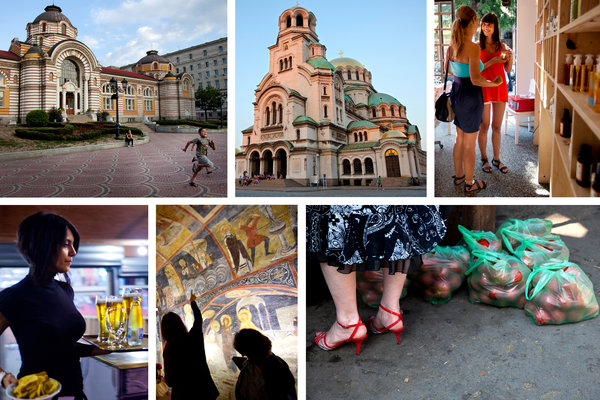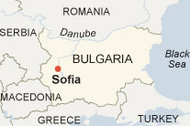36 Hours in Sofia, Bulgaria
Clockwise from top left: Central Mineral Baths, Alexander Nevski Cathedral, Shipka, Ladies’ Market, Boyana Church and SkaraBar.
By CHRISTINE AJUDUA
Published: August 30, 2012
FIRST came the Thracians, about 2,700 years ago, followed by the Romans, the Byzantine Empire, the Ottoman Turks and then the Communists. These days — more than two decades after the fall of the Iron Curtain, and five years after joining the European Union — the Bulgarian capital is finally coming into its own. In place of the old Lenin monument, a statue of Sofia’s patron saint now stands tall — a dark princess that somehow embodies the city’s East-meets-West, old-meets-new allure. Under her gaze, a youthful, creative energy displays itself as Sofia angles for the title of European Capital of Culture 2019.
Friday
6 p.m.
1. THE YELLOW BRICK ROAD
Most of Sofia’s main sights lie within the small city center, where, in contrast to the Soviet-style blocks on the way in from the airport, the streets are paved a cheery yellow. On the two-hour Free Sofia Tour (Palace of Justice, 2 Vitosha Boulevard; 359-88-699-3977; freesofiatour.com), offered twice daily by local Ph.D. students and plugged-in volunteers, stops include the gold-domed Alexander Nevski Cathedral; the early-20th-century Central Mineral Baths (closed for more than two decades, the building, with its neo-Baroque and neo-Byzantine influences, is scheduled to reopen by 2014 with a spa and a history museum); and the Serdika subway underpass. There, recently unearthed relics of ancient Sofia are now being put on display — the first phase of a subterranean archaeological complex, set to be completed next year.
8 p.m.
2. BULGARIAN BARBECUE
The country’s convoluted past is reflected in its hearty cuisine, which combines Central Asian and European flavors. At SkaraBar (12 Georgi Benkovski Street or 2 Dimitar Grekov; 359-2-483-4431 or 359-2-483-0696; skarabar.com), a barbecue joint with retractable floor-to-ceiling windows, try the meshana skara platter (15.80 leva, or about $10.40 at 1.52 leva to the dollar), with skewered lamb and sausages, including a delicious spiced-pork kebapcheta. Bulgarian wines by the bottle start at 19.90 leva and shots of grape- and plum-based rakia, the Balkan digestif, start at 2.10 leva. Over at the bistro Lubimoto, “Favorite” (25 General Parensov Street; 359-88-477-8464; lubimoto.com), patrons wax poetic about the slow-cooked pork loin (8.49 leva).
10 p.m.
3. ART-BAR CRAWL
The bright green Kraft Paints building is the only thing marking the entrance to Hambara (6 Septemvri), a secret hangout for artists and intellectuals during the Communist regime that is still lighted by candles — rather precariously, given the wooden interiors. Easier to find is A:part:mental (68 Neofit Rilski Street; 359-87-878-7321), a century-old residence turned African embassy turned gallery-cafe-bar that showcases local artwork while serving raspberry wine (5 leva) and health-conscious cakes (5 leva). Two years ago, Kino Vlaikova (11 Tsar Ivan Assen II; 359-87-985-5819; vlaikova.com), a circa 1927 cinema, turned into a venue for indie bands and Zagorka-swigging hipsters. Farther east, there’s the chic new Kanaal (2 Madrid Boulevard; 359-88-2-856-346; kanaal.bg), a Dutch-inspired spot with Trappist beers (from 5.50 leva) and art shows.
Saturday
10 a.m.
4. EXHIBIT A: SOCIALISM
Last September, the government sought to contain Bulgaria’s Communist past in the new Museum of Socialist Art (7 Lachezar Stanchev Street; 359-2-980-0071;nationalartgallerybg.org; 6 leva), on the city’s southeastern outskirts. Inside, you’ll find paintings and other works created in the country between 1944 and 1989 and black-and-white propaganda shorts. A sculpture park is dotted with statues of former Bulgarian Communist Party leaders and prime ministers including Georgi Dimitrov and Vasil Kolarov, not to mention Lenin. You can buy caps and T-shirts adorned with their likenesses in the gift shop.
1 p.m.
5. SOUP-ER COOL
Perhaps only in Sofia would two of the latest culinary hot spots be all about soup. Supa Star (8 Tsar Ivan Shishman Street; 359-88-290), done up with whimsical artworks and colorful lighting fixtures, offers everything from tarator (2.70 leva) — a Bulgarian classic with cucumbers, walnuts and a chilled yogurt base — to tiger-prawn Thai soup (5 leva). Not to be outdone, Soup Me (55 Neofit Rilski Street; 359-88-862-6525), where a ladle serves as the door handle and silver pots have been fashioned into ceiling lamps, serves specials like shkembe chorba (or tripe soup; from 3.80 leva).
3 p.m.
6. MADE IN BULGARIA
One of the city’s best-kept secrets is its homegrown shopping scene. Kalina Petrova stocks organic beauty products in the recently converted butchery that is Shipka (23 Professor Asen Zlatarov; 359-88-952-2022; shipka.bg), meaning rosehip; among the meat hooks downstairs, you can make your own lotions and potions using Bulgarian rose oil and other natural ingredients. Nearby, Le Petit Salon (1 Tsar Ivan Asen II; 359-88-920-0558 or 359-88-564-4170; lepetitsalon.eu) is a showcase for stylish local wares, from embroidered linen dresses to the co-owner Tita Koycheva’s gorgeously melancholy ceramic and papier-mâché dolls. For colorful hand-sewn children’s quilts, tees and toys, try Nenios (25 Solunska Street; 359-87-725-0257; nenios.com). And don’t miss Tochka & Tochka’s whimsical glazed porcelain mugs at Testa Gallery (8 Tsar Shishman Street; 359-2-981-8363; testagallery.com), which also stocks contemporary jewelry from local designers.
7 p.m.
7. TEA TIME
The red-walled Tea House (11 Georgi Benkovski Street; 359-88-705-1080;teahousesofia.com) draws bohemians and expats for its evening jam sessions, poetry readings, vegan food and 60-plus types of tea (from 1.90 leva), spiking optional. In keeping with its location in a former paper factory, the owners have opened a secondhand English-language bookstore in the back.
9 p.m.
8. CULTURE CLUBS
Near the southern end of Vitosha Boulevard sits a massive (1,323,961-square-foot) Communist-era complex: the National Palace of Culture, a k a NDK. It doesn’t look inviting, what with the No Guns signs, but locals flock to its clubs and concert halls, especially to the Balkan jazz bar, Studio 5 (1 Bulgaria Square, entrance A3; 359-2-963-1254; clubstudio5.com), which welcomes a couple of outfits each night, from a student ska-metal group to the Bulgarian jazzman Theodosii Spassov on the kaval, plus tango and comedy acts. Around the building and up a few flights, Culture Beat (359-89-681-3234 or 359-89-845-3400; culturebeatclub.com) is a cosmopolitan lounge with mosaic-tile floors.
11 p.m.
9. DANCE THE NIGHT AWAY
In the NDK neighborhood the pedestrian Lovers’ Bridge is where young couples stroll while taking in open-air photo exhibits and views of Vitosha Mountain. The bridge stretches from the base of the Palace and over an underpass lined with nightclubs. One of the newest is Horoteka (1 Cherni Vrah Boulevard; 359-88-850-5045; horoteka.bg; 5 leva) where, fueled by Shumenskos (2.50 leva) and Red Bulls (5 leva each) and an enthusiastic D.J., Sofia’s youth do variations of the horo — a traditional Bulgarian line dance. Keen on mastering the steps? Take a group lesson (6 leva per person), or buy a DVD tutorial (12 leva) at the bar.
Sunday
11 a.m.
10. TO MARKET, TO MARKET
The outdoor Zhenski Pazar, or Ladies’ Market (Stefan Stambolov Boulevard), and the neo-Renaissance-style and neo-Byzantine Central Hall market hall (25 Knyaginya Maria Luiza Boulevard), built in 1909 on the site of the Serdika fortress are colorful, if chaotic locales (and prime ground for pickpockets) where babushkas hawk everything from pottery to banitsa — a cheesy phyllo pastry eaten for breakfast with boza, Bulgaria’s favorite malt drink. You might find an organic version — or bioboza (2.50 leva) — at +Tova (30 Marin Drinov; 359-88-720-3340; plustova.com), which also offers quiches (4 leva) and multimedia exhibits.
2 p.m.
11. OLD-WORLD TREASURES
Take a taxi to the medieval Boyana Church (1-3 Boyansko Ezero Street; 359-2-959-0939 or 359-2-959-2963; boyanachurch.org; 10 leva), a Unesco World Heritage site in the foothills of Vitosha Mountain renowned for its icon paintings and frescoes. At the nearby National History Museum (16 Vitoshko Lale Street; 359-2-955-4280; historymuseum.org; 10 leva), the former residence of the country’s last Communist leader, Todor Zhivkov, you can see the recently discovered medieval “vampire” skeleton with an iron stake in its heart and a glittering collection of Thracian accouterments.
IF YOU GO
With its floral-patterned facade, mod basement-level restaurant, and 31 brightly colored rooms, Les Fleurs (21 Vitosha Boulevard; 35-2-8-100-800; lesfleurshotel.com; from 100 euros, about $121) is a lively presence in Sofia’s boutique hotel scene. (Prices are given in euros.)
For a more historic setting, try the new Arena di Serdica (2-4 Budapeshta Street; 359-2-810-7777; arenadiserdica.com; from 110 euros), with 63 spacious rooms and suites and a spa on the site of a Roman amphitheater. A section of the ruins lie within the lobby; you can see ancient animal footprints in the clay-stone walls.


















